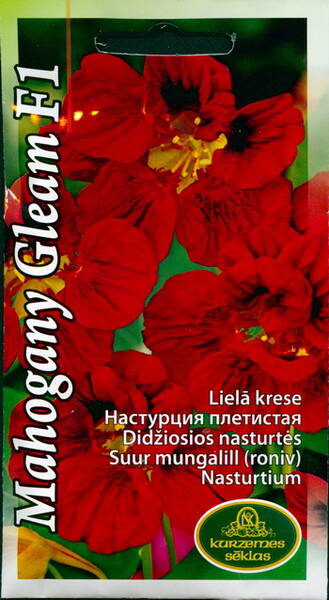An abundance of double flowers.
Semi-creeping shoots up to 1.5 m long. Flowers with a pleasant aroma.
Blooms profusely from July until frost.
Used for vertical gardening, balcony boxes.
Location: nasturtiums are thermophilic and photophilous.
Soil: Prefer moderately fertile and moist soils.
Care: with an excess of fertilizers, especially organic ones, the plants form large dark green leaves to the detriment of flowering. And with a lack of light, the stems are drawn out, and the leaves become small, which significantly impairs the decorative effect. Before flowering, regular watering is necessary, but after flowering begins, water only when the soil dries out. Top dressing (mainly potassium-phosphorus fertilizers) is also carried out before flowering. When all these conditions are met, nasturtium will bloom from June until the very frost.
Reproduction: seeds that can be sown directly into the ground in mid-May, in holes of three seeds, maintaining a distance between holes of 25-30 cm, but seedlings can be grown for earlier flowering. Sow in the first days of May in 9 cm pots of 3 pieces. Seedlings appear in two weeks. Landing in the ground is carried out only with an earthen clod in early June.
And cuttings that take root perfectly in water and in wet sand. This technique is used when propagating new (especially terry varieties).
Since nasturtium is a perennial plant, it is possible to leave the most outstanding specimens to winter in a pot on a bright, cool window with limited watering, and cut them in the spring.
Under favorable conditions, nasturtium sets a lot of seeds, which, crumbling, are able to overwinter in the soil.
Usage: undersized types and varieties of nasturtiums are suitable for vases, borders, flower beds in the form of wide ribbons. Species and varieties with long shoots are used as ampelous plants, for vertical gardening and as ground cover.
Eng.: Climbing nasturtium, Indian cress, Lark's heel.
* In ordinary garden nasturtiums, all parts of the plant are edible, except for the roots.
Rich in vitamin C, fresh young leaves and stems add some piquancy to salads and sandwiches, extracts from the flowers are added to cheeses and butter, vinegar is infused on nasturtium flowers, stuffed with various fillings, and also used as an edible decoration in salads, soups and drinks.
Finally, the dried, peeled, and ground seeds have a spicy, peppery flavor and are used as a seasoning for a wide variety of dishes (it is said that many countries used ground nasturtium seeds rather actively in place of black pepper during World War II).
Nasturtium is used not only as an ornamental and edible plant, but also as a medicinal plant. It treats beriberi, anemia, skin rashes, kidney stone disease, bronchitis and other diseases, it promotes hair growth. Especially well established nasturtium as an antiscorbutic agent. The amount of vitamin C in it reaches 500 mg% or more (ten times higher than in ordinary lettuce leaves!)
It is even richer in strong antimicrobial substances: phytoncides and provitamin A. Clinical trials of tropolein, a substance isolated from nasturtium essential oil, showed that when it was used in patients with chronic coronary insufficiency caused by atherosclerosis, angina attacks stopped, pain disappeared, and health improved.
Nasturtium became very popular when it was found that dishes from it have dietary and medicinal properties in a number of diseases, and especially in atherosclerosis and metabolic disorders associated with age-related changes. It has been established that tubers in tuberous species contain substances that reduce the level of testosterone in the body and thus act as anti-Viagra. That is probably why the Inca commanders always included "mashua" in the diet of their soldiers!












